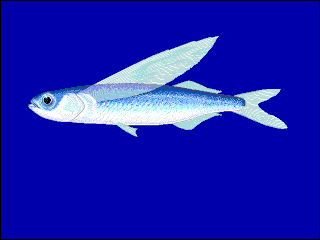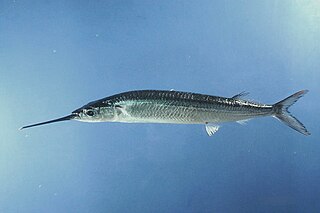Hemiramphidae is a family of fishes that are commonly called halfbeaks, spipe fish or spipefish. They are a geographically widespread and numerically abundant family of epipelagic fish inhabiting warm waters around the world. The halfbeaks are named for their distinctive jaws, in which the lower jaws are significantly longer than the upper jaws. The similar viviparous halfbeaks have often been included in this family.

Beloniformes is an order composed of six families of freshwater and marine ray-finned fish:

The cherubfish, also known as the pygmy angelfish, is a species of marine ray-finned fish, a marine angelfish belonging to the family Pomacanthidae. It is found in the western Atlantic Ocean.

The Dussumier's halfbeak, also known as the slender garfish, lives in reefs and shallow lagoons. It is an Indo-Pacific species which is found from the Seychelles east to the Tuamotu Islands, north to Hong Kong and Okinawa and south to northern Australia. They form schools which are found near the surface of lagoons and seaward reefs. The longest known specimen was 38.0 cm in length. This species was described by Achille Valenciennes in 1847 with the type locality given as the Seychelles. The specific name honours the French voyager and merchant Jean-Jacques Dussumier (1792-1883).

Seth Eugene Meek was an American ichthyologist at the Field Museum of Natural History in Chicago. He was the first compiler of a book on Mexican freshwater fishes. Together with his assistant, Samuel F. Hildebrand, he produced the first book on the freshwater fishes of Panama.
The resplendent pygmy angelfish is a species of marine ray-finned fish, a marine angelfish, belonging to the family Pomacanthidae. It is endemic to Ascension Island in the South Atlantic Ocean.
Nomorhamphus weberi is a species of viviparous halfbeak endemic to Lake Matano in Sulawesi, Indonesia. This species can reach a length of 7.5 centimetres (3.0 in) SL. The specific name honours the Dutch ichthyologist Max Carl Wilhelm Weber (1852-1937).
Tondanichthys kottelati is a species of viviparous halfbeak endemic to Indonesia, where it is only known from Lake Tondano near Mount Tondano in the far north of the island of Sulawesi. It grows to a length of 6.4 centimetres (2.5 in) SL. Despite being a member of the viviparous halfbeak family, this species is believed to be oviparous. This species was described in 1995 by Bruce Baden Collette and its species name honours the Swiss ichthyologist Maurice Kottelat.
Allen's river garfish is a species of viviparous halfbeak endemic to West Papua in Indonesia.
Robert's river garfish is a species of viviparous halfbeak endemic to Papua New Guinea where it is only known from the area around Kokoda. This species grows to a length of 13 centimetres (5.1 in) SL.

Hyporhamphus is a genus of halfbeaks. The species in this genus are distributed throughout the warmer seas of the world, most species being Indo-Pacific and there are some freshwater species.
Ecsenius collettei, known commonly as the Collete's blenny in Papua New Guinea, is a species of combtooth blenny in the genus Ecsenius. It is found in coral reefs in the western central Pacific ocean, specifically in Papua New Guinea. It can reach a maximum length of 5 centimetres. The blennies feed primarily off of plants, and benthic algae and weeds. he specific name honours Bruce B. Collette the Director of the National Marine Fisheries Service Systematics Laboratory, whose collection of fish specimens from New Guinea contained a number important blenniid specimens, one of which was this species.
Rhynchorhamphus georgii or long-billed halfbeak is a halfbeak of the family Hemiramphidae of the order Beloniformes.
Hyporhamphus yuri is a halfbeak from the family Hemiramphidae which has been reported from Okinawa and nearby islands in the north-west Pacific Ocean. This species was described by Bruce Baden Collette & Nikolai Vasilyevich Parin in 1978 from a type obtained at the Naha Market in Okinawa. The specific name honours the Russian ichthyologist Yuri Nikolayevich Shcherbachev of the Institute of Oceanology, Academy of Sciences of the USSR.

The American halfbeak, also known as Meek's halfbeak, is a halfbeak from the family Hemiramphidae.
Bruce Baden Collette is an American ichthyologist.
The black-tipped halfbeak, Hyporhamphus neglectissimus, is a halfbeak from the family Hemiramphidae.
Dermogenys collettei is a species of viviparous halfbeak found in freshwater areas in Thailand, Malaysia, Singapore, and Indonesia. This species was described in 2001 by Amy Downing Meisner with the type locality given as Kuching in Sarawak. The specific name honours the American ichthyologist Bruce Baden Collette.

Hyporhamphus unifasciatus, the common halfbeak or the Atlantic silverstripe halfbeak, is a bony fish in the family Hemiramphidae. It is found in the subtropical western Atlantic Ocean and the Gulf of Mexico. It is a common fish and not used for food to any great extent, and the International Union for Conservation of Nature has listed its conservation status as being of "least concern".
Arrhamphus krefftii, the snub-nosed garfish, is a species of halfbeak in the genus Arrhamphus found in coastal waters of Australia from south of Rockhampton in Queensland to Sydney. The identity of the person honoured in the specific name is uncertain but it is thought that it may be the Australian zoologist and paleontologist Gerard Krefft (1830–1881). This species was previously classified as a subspecies of Arrhamphus sclerolepis, and remains so according to some authorities.






